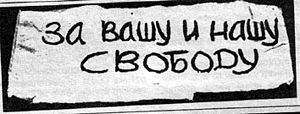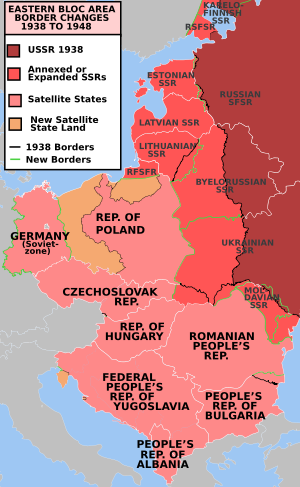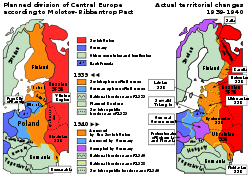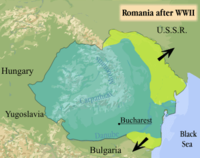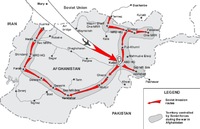- Soviet occupations
-
Soviet occupations is a term used for military occupations by the Soviet Union from the prelude to the aftermath of World War II.[1][2][3] The term is typically used for occupations of Eastern European countries. The degree of control that the Soviet Union exercised over the governments of occupied countries varied widely from country to country, and changed over time.
Contents
Variations
Some Communist states created after World War II, such as Albania and Yugoslavia, were not occupied by Soviet forces. Their leaders had been approved by Joseph Stalin and initially maintained good relations with the Soviet Union, but later came to oppose the Soviets on matters of foreign policy and other major issues.[4] Other countries were occupied by the Red Army briefly, but Soviet forces left after completing their military operations or after several years. This was the case in Iran, Romania, North Korea, and China. These countries were eventually able to gain significant political independence from the Soviet Union.
A third group of countries are those where the Soviet Union maintained a military presence for the entire duration of the Cold War, and whose internal affairs were influenced but not directly controlled by the USSR. These are five countries, located primarily in Eastern Europe: Bulgaria, Hungary, Czechoslovakia, Poland and the German Democratic Republic. Western sources often refer to these countries as being Soviet "satellite states." Officially, they were independent and sovereign nation-states, and the Soviet troops on their territory were permitted to stay there only at the invitation of each country's own government. Unofficially, the Soviet government had considerable influence over the leaders of these countries, controlled their foreign policy, and could place limits on what was considered acceptable internal policy. The countries were more or less free to decide their own policies within those limits, but when they stepped out of bounds, Soviet armed forces could intervene to restore control. Such interventions happened on two occasions, during the Hungarian revolution of 1956 and the Prague Spring.
Finally, there is a fourth group, consisting of Lithuania, Latvia, and Estonia, which were directly annexed to the Soviet Union during World War II. In this case, Red Army troops were present on their territory because those countries formed part of the Soviet Union itself, and thus the Red Army was officially considered to be their own national army. Soviet authority in these states consisted of direct political control rather than informal influence. Also, it was largely represented by civilian officials, which has led to their occupation being sometimes described as a civil occupation as distinguished from a military occupation.[5]
Importantly, two countries partially occupied by the Soviet Union - namely Germany and Austria - were jointly occupied by all the major victors of World War II in Europe (the Four Powers). Iran was occupied in 1941 by joint Anglo-Soviet forces. The United States and the United Kingdom, the allies of the USSR against Germany during World War II de facto recognized the occupation of the Eastern European states by the USSR at Yalta Conference in 1945.
World War II
Further information: Eastern BlocDuring World War II, the Soviet Union annexed several countries as Soviet Socialist Republics that were originally effectively ceded to it by Nazi Germany in the Molotov-Ribbentrop Pact's secret protocol. These included Eastern Poland (incorporated into two different SSRs),[6] Latvia (became Latvian SSR),[7][8] Estonia (became Estonian SSR),[7][8] Lithuania (became Lithuanian SSR),[7][8] part of eastern Finland (became Karelo-Finnish SSR)[9] and eastern Romania (became the Moldavian SSR).[10][11]
Bessarabia and Northern Bukovina
Main article: Soviet occupation of Bessarabia and Northern BukovinaThe Soviet Union, which did not recognize the sovereignty of Romania over Bessarabia since the union of 1918, issued an ultimatum on 28 June 1940 demanding the evacuation of the Romanian military and administration from the territory it contested as well as from the northern part of the Romanian province of Bukovina[12] with an implied threat of invasion in the event of non-compliance.[12] Under pressure from Moscow and Berlin, the Romanian administration and armed forces retreated to avoid war. Adolf Hitler used Soviet occupation of Bessarabia as justification for German occupation of Yugoslavia and Greece and German attack on USSR.
Baltic states
Soviet occupation of the Baltic States[13] When World War II started in September 1939, the fate of Baltic countries had been already decided in the German-Soviet Nonaggression Pact and its Secret Additional Protocol of August 1939.[14]
In the Baltic states — Estonia, Latvia and Lithuania —, occupations were initiated by the Soviet Union pressuring all three to accept Soviet military bases, threatening to attack immediately in case of refusal. Soviet Union also attempted this tactic on Finland; however, Finland refused, leading to the Winter War, and later, the Continuation War (World War II).
Soon after creation of these bases, Soviet military forces left them and overtook political systems of these countries. However, all three Baltic states undertook specific steps to retain the republics' legal standing, leading to USA and other Western democracies to explicitly not recognise the legality of the occupations under Stimson's doctrine and related principles. This allowed eventual restoration of Republic of Estonia, Republic of Latvia, and Republic of Lithuania under the doctrine of continuation of these republics as they had existed before World War II.
Another aspect of these occupations was that they were cut in half by Germany's successful military actions in the Eastern front. All three Baltic states, having been occupied by Soviet Union, were in 1941–1944 occupied by Germany and administered through the Reichskommissariat Ostland. Significant differences between the styles of administration of Soviet Union and Nazi Germany — one-time allies — eventually led significant numbers of natives of all three countries to align themselves with Germany for the sole objective of stalling, and possibly preventing, another Soviet occupation.
During the occupation, the Soviet Union killed, drafted (unlawfully under international law) into the Red Army and deported hundreds of thousands of people. Furthermore, trying to enforce the ideals of Communism, the Soviet Union deliberately dismantled the existing social and economic structures, and imposed new, "ideologically pure" hierarchies. This severely retarded economies of all three Baltic states. For example, Estonian scientists have estimated Estonia's economic damages directly attributable to the second Soviet occupation to hundreds of billions of US dollars (several dozens worth of Estonia's 2006 GDP of $21.28 billion[15]). Soviet neglect for environmental protection led to extensive ecological damage as well; for Estonia, the damage is estimated to about 4 billions of US dollars. In addition to direct damages, retardation of the economic systems led to severe wealth gap between the Baltic states and their neighbouring European states that stayed free of the Soviet yoke, such as Finland (whose standard of living Estonia had been on par with before World War II) and Sweden.
After the collapse of the Soviet Union the Baltic States' struggle for independence came to a conclusion, the sovereignties of the countries were restored in 1991. The last Soviet troops withdrew from the Baltic States in August 1994.[16]
Although Soviet Union has condemned the Molotov-Ribbentrop Pact of 1939 — the immediate forerunner to the occupation —, as of 2007[update] it is generally the policy of Russian Federation to deny that the events involved constituted occupation or were illegal under applicable (international) laws.[17]
Finnish territories
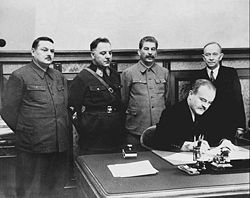 Molotov signing a deal between the Soviet Union and the short-lived puppet state Finnish Democratic Republic, which existed on occupied territories during the Winter War.
Molotov signing a deal between the Soviet Union and the short-lived puppet state Finnish Democratic Republic, which existed on occupied territories during the Winter War. Main articles: Finnish Democratic Republic and Winter WarSee also: Karelian question in Finnish politics
Main articles: Finnish Democratic Republic and Winter WarSee also: Karelian question in Finnish politicsSoviet Union demanded that Finland agree to move the border further away from Leningrad. It also demanded that Finland lease the Hanko Peninsula (or similar territory at the entrance to the Gulf of Finland) to the USSR for the creation of a naval base there.[18] However, Finland refused, and the Soviet Union invaded Finland, initiating the Winter War. In the territories occupied by the Soviet Union in the Finnish Karelia, they set up the Finnish Democratic Republic (Finnish: Suomen kansanvaltainen tasavalta), a short-lived Soviet puppet regime. The Soviets also occupied Petsamo in the North during the war. Later, Finland was forced to cede the Finnish part of Karelia in the Moscow Peace Treaty of 12 March 1940. The land included the city of Viipuri (the country's second largest city), much of Finland's industrialized territory, and significant parts still held by Finland's army: nearly 10% of pre-war Finland. About 422,000 Karelians — 12% of Finland's population — lost their homes. Military troops and remaining civilians were hastily evacuated. Finland also had to cede a part of the Salla area, the Kalastajansaarento peninsula in the Barents Sea and four islands in the Gulf of Finland. The ceded areas were integrated within the Karelian ASSR to form the Karelo-Finnish SSR.
When the hostilities resumed in 1941, the Soviet Union occupied Petsamo once again in 1944, but elsewhere their advance was halted before they could enter Finnish territory. This time, whole Petsamo was ceded to the Soviet Union by Finland in the Moscow Armistice.
Other World War II occupations
Bornholm
1944-1946 Soviet troops occupied northern Norway and the Danish island of Bornholm, strategically situated at the Baltic sea entrance. The Americans viewed these forces as intended to establish a Soviet claim for base rights.
Bornholm was heavily bombarded by Soviet forces in May 1945. Gerhard von Kamptz, the German superior officer in charge failed to provide a written capitulation as demanded by the Soviet commanders, several Soviet aircraft relentlessly bombed and destroyed more than 800 civilian houses in Rønne and Nexø and seriously damaged roughly 3000 more during 7 – 8 May 1945. On 9 May, Soviet troops landed on the island and after a short fight the German garrison did surrender.[19] Soviet forces left the island on 5 April 1946.
Further information: Bornholm#HistoryAnglo-Soviet occupation of Iran
Main article: Anglo-Soviet invasion of IranThe Anglo-Soviet invasion of Iran was the invasion of Iran by British and Commonwealth forces and the Soviet Union, codenamed Operation Countenance, from 25 August to 17 September 1941. The purpose of the invasion was to secure Iranian oil fields and ensure supply lines (see Persian Corridor) for the Soviets fighting against Nazi Germany on the Eastern Front.
End of World War II
Further information: History of the Soviet Union (1927–1953) and Eastern BlocAt the end of World War II, the Soviets occupied several other states that were converted into Soviet Satellite states, such as the People's Republic of Poland, the People's Republic of Hungary,[20] the Czechoslovak Socialist Republic,[21] the People's Republic of Romania, the People's Republic of Albania,[22] and later East Germany from the Soviet zone of German occupation.[23]
Hungary
Main article: Soviet occupation of HungaryIn July 1941, the Kingdom of Hungary, a member of the Tripartite Pact, took part in Operation Barbarossa, in alliance with Nazi Germany. Hungarian forces fought shoulder to shoulder with the Wehrmacht and advanced through the Ukrainian SSR deep into Russia, all the way to Stalingrad. However, by the end of 1942 the Soviet Red Army began pushing back the Wehrmacht through a series of offensives that preceded the Red Army's encroachment upon Hungarian territory in 1943-44. In September 1944 Soviet forces crossed into Hungary, launching the Budapest Offensive. As the Hungarian army ignored the armistice with the USSR signed by the government of Miklós Horthy on 15 October 1944, the Soviets fought their way further westward against the Hungarian troops and their Nazi allies capturing the capital on 13 February 1945. Operations continued until 4 April 1945, when the last Nazi forces and the remaining Hungarian troops loyal to the Germans were routed out of the country.
The Soviets made sure that a loyal post-war government dominated by Communists was installed in the country before transferring authority from the occupational force to the Hungarian authorities. The presence of Soviet troops in the country was regulated by the 1949 mutual assistance treaty concluded between the Soviet and Hungarian governments. The Hungarian Revolution of 1956 was a spontaneous nationwide revolt against the Communist government of Hungary and its Soviet-imposed policies. After announcing a willingness to negotiate the withdrawal of Soviet forces, the Soviet Politburo changed its mind. On 4 November 1956, a large joint military force of the Warsaw Pact led by Moscow, entered Budapest to crush the armed resistance, killing thousands of civilians in the process.
After the collapse of the Soviet Union, the last Soviet soldier left the country in 1991, thus ending Soviet military presence in Hungary.
Poland
Main articles: Soviet invasion of Poland (1939), Polish areas annexed by the Soviet Union, Occupation of Poland (1939-1945), and Northern Group of ForcesPoland was the first country to be occupied by Soviet Union during the World War II era.
Under the Molotov-Ribbentrop pact, the alliance of Soviet Union and Nazi Germany designated Poland to be split in two in their joint invasion of Poland.[24] In 1939, the total area of Polish territories occupied by the Soviet Union (including the area given to Lithuania and annexed in 1940 during the formation of Lithuanian SSR), was 201,015 square kilometres, with a population of 13.299 million, of which 5.274 million were ethnic Poles and 1.109 million were Jews.[25]
After the end of World War II, the Soviet Union kept most of the territories it occupied in 1939, while territories with an area of 21,275 square kilometers with 1.5 million inhabitants were returned to communist-controlled Poland, notably the areas near Białystok and Przemyśl.[26] In the years 1944-1947, over a million Poles were resettled from the annexed territories into Poland (mostly into the Regained Territories).[27]
Soviet troops (the Northern Group of Forces) were stationed in Poland from 1945 till 1993. It was only in 1956 that official agreements between communist regime in Poland established by Soviets themselves and Soviet Union recognized the presence of those troops; hence many Polish scholars accept the usage of term 'occupation' for period 1945-1956.[28] Other scholars date the Soviet occupation till 1989.[29][30] The Polish Government in Exile existed until 1990.
Romania
Main article: Soviet occupation of RomaniaAlready in March 1939, under the "heavy pressure of circumstances" the Kingdom of Romania signed a trade treaty with the Third Reich which according to Time magazine was eventually expected to reduce if not wipe out all commerce between Romania and other states. "In no instance of modern times has one State made such humiliating, far-reaching economic concessions to another as Rumania's King Carol II made in Bucharest last week to Dr. Helmuth Wohlthat, Führer Hitler's traveling salesman."[31] To counter the Soviet occupation of Bessarabia and Northern Bukovina, which started with an ultimatum on June 26, 1940, Romania sought alliances other than the traditional French-British security assurances, i.e. with the Germany, which eventually proved illusory.
On July 1, 1940, Romania renounced the Anglo-French guarantee that dated from April 13, 1939, and three days later Prime Minister of Romania became the pro-German Ion Gigurtu, who on July 11 took Romania out of the League of Nations, and on July 13 announced her desire to join the Axis camp.[32] From July 5, 1940, Romania allied itself with Nazi Germany, only to be invaded in 1940-1941 by its "ally" as part of Hitler's strategy to create one huge eastern front against the Soviet Union.[33] In June 1941, a large part of Romanian army took part in the Axis invasion of the Soviet Union. After quick initial successes by the Axis forces, Romania recaptured the provinces of Bessarabia and northern Bukovina (which had been occupied by the Soviets a year earlier), and occupied parts of Southern Ukraine, between the Dniester and Southern Buh rivers. Furthermore, the Romanian dictatorship of Ion Antonescu continued to fight side by side with the forces of Nazi Germany elsewhere on the Eastern Front. By 1942 and 1943 the tide of the war was turning as the Red Army regained territory it had lost in 1941. In 1944, the Soviets reached their pre-invasion western border and advanced westward to defeat Germany and its allies. It was in the context of these events that Soviet forces fought the Battle of Romania (August 1944) and continued to advance westward, reaching the capital Bucharest on 31 August. On August 23, 1944, Romania's King Michael I launched the coup d'état overthrowing Antonescu's pro-Nazi government of and switching Romania to the Allies (see King Michael Coup).
"Soviet occupation of Romania" refers to the period between 1944 and 1958, when Soviet troops were stationed in this country.[34] On 12 September 1944, with the Red Army already controlling much of Romania's territory, an Armistice Agreement between Romania and the USSR was signed, under which Romania retroceded the territory it administered earlier in the war, and subjected itself to an allied commission consisting of the Soviet Union, the United States, and the United Kingdom. On the ground, it was the Soviet military command, and not the Western allies, that de facto exercised dominant authority. The presence and free movement of Soviet troops was explicitly stipulated in the agreement.[35]
The terms of the Armistice Agreement ceased on 15 September 1947 as the conditions of the Paris Peace Treaty entered into force. The new treaty stipulated the withdrawal of all Allied forces from Romania with an important exemption that such withdrawal was "subject to the right of the Soviet Union to keep on Romanian territory such armed forces as it may need for the maintenance of the lines of communication of the Soviet Army with the Soviet zone of occupation in Austria."
In the aftermath of the agreement the Soviet presence fell from 130,000 troops (the peak in 1947) to approximately 30,000. The troops were fully withdrawn by August 1958.
Comparing the Soviet occupation of Romania to that of Bulgaria, David Stone notes: "Unlike Bulgaria, Romania had few cultural and historical ties with Russia, and had actually waged war on the Soviet Union. As a result, Soviet occupation weighted heavier on the Romanian people, and the troops themselves were less disciplined."[36]
Bulgaria
On 5 September 1944, the Soviet Union declared war on Bulgaria and invaded the country. Within three days the Soviets occupied the northeastern part of Bulgaria along with the key port cities of Varna and Burgas. On 8 September 1944, Bulgaria changed sides in the war and joined the Soviet Union in its war against Nazi Germany. Garrison detachments with Zveno officers at the head overthrew the government on the eve of 9 September, after taking strategic keypoints in Sofia and arresting the ministers. A new government of the Fatherland Front was appointed on 9 September with Kimon Georgiev as prime minister.
Germany
Main articles: Soviet occupation zone and History of the German Democratic RepublicSoviet occupation zone of Germany was the area of eastern Germany occupied by the Soviet Union from 1945 on. In 1949 it became The German Democratic Republic known in English as East Germany.
In 1955 the Republic was declared by the Soviet Union to be fully sovereign; however, Soviet troops remained, based on the four-power Potsdam agreement. As NATO troops remained in West Berlin and West Germany, the GDR and Berlin in particular became focal points of Cold War tensions.
A separation barrier between West and East Germany, the Berlin Wall known in the Soviet Union and in East Germany as the "Anti-Fascist Protective Rampart,"[37] was built in 1961.
The Treaty on the Final Settlement With Respect to Germany signed in Moscow, mandated the withdrawal of all Soviet forces from Germany by the end of 1994. Conclusion of the final settlement cleared the way for unification of East and West Germany. Formal political union occurred on 3 October 1990.
One result of the occupation was children fathered by Russian soldiers either through romantic relationships, relationships of convenience or rape. These children experience societal discrimination for decades but after the troops withdrawal and the development of perestroika, some of these "Lost Red Army Children" made public attempts to discover more about their Russian fathers.[38]
Austria
Main article: Allied-administered AustriaThe Soviet occupation of Austria, 1945-1955.[39] At the end of the war, Austria and Vienna were divided into 4 zones of occupation, following the terms of the Potsdam Conference. The country was earmarked for heavy economic exploitation. The Soviet Union expropriated over 450 businesses, formerly German-owned.
On 15 May 1955, the Austrian State Treaty was signed, officially establishing Austrian independence and sovereignty. The treaty was enacted on 27 July, and the last Allied troops left the country on 25 October.
Post-WWII Europe
Soviet Union 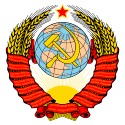
This article is part of the series:
Politics and government of
the Soviet UnionGovernment- Constitution
- Government
- Ministries
- State Committees
- Executive Officer
- Council of People's Commissars
- Council of Ministers
- Cabinet of Ministers
- State Council
- Presidential Council
CPSULeadership- Leaders
- Premiers
- Cabinets
- President (List)
- Vice President
- Collective leadership
Legislature- Congress of Soviets
- Central Executive Committee
- Supreme Soviet
- Congress of People's Deputies
- Speaker
- 1989 Legislative election
Judiciary- Law
- Supreme Court
- People's Court
- Procurator General
Economy- Economy
- Agriculture
- Consumer goods
- Five-Year Plan
- Kosygin reform
- New Economic Policy
- Science and technology
- Era of Stagnation
- Material balance planning
Society- Culture
- Demographics
- Education
- Family
- Phraseology
- Religion
- Transport
- Repression
- Censorship
- Censorship of images
- Economic repression
- Great purge
- Gulag system
- Collectivization
- Human rights
- Mass killings
- Ideological repression
- Suppressed research
- Political abuse of psychiatry
- Political repression
- Population transfer
- Propaganda
- Red Terror
Hungary
Soviet forces intervened into the events of the Hungarian Revolution of 1956 and suppressed the movement for reform.
Czechoslovakia
Main articles: Prague Spring and Soviet occupation of CzechoslovakiaSoviet Occupation of Czechoslovakia [40] In 1948, the Czech Communist Party won a large portion of the vote in Czechoslovak politics, leading to a communist period without immediate Soviet military presence. The 1950s were characterized as a repressive period in the country’s history, but by 1960s, the local socialist leadership had taken a course toward toward economic, social and political reforms. However, a number of significant Czech communists, together with the Czech security agency, conspired against limited introduction of market systems, personal freedoms, and renewal of civic associations (see Socialism with a human face) by leveraging Russian support towards strengthening Communist Party's positions.
Leonid Brezhnev, General Secretary of the Communist Party of the Soviet Union, reacted to these reforms by announcing the Brezhnev Doctrine, and in 21 August 1968, about 750,000 Warsaw Pact troops, mostly from the Soviet Union, Poland, Bulgaria, East Germany and Hungary, with tanks and machine guns occupied Czechoslovakia, deported thousands of people and rapidly derailed all reforms. Most large cities were individually invaded and overtaken; however, the invasion's primary attention focused on Prague, particularly the state organs, Czech television and radio.
The Czechoslovak government held an emergency session, and loudly expressed its disagreement with the occupation. Many citizens joined in protests, and by September 1968 at least 72 people had died and hundreds more injured in the conflicts. In the brief time after the occupation, which had put an end to any hope that Prague Spring had created, about 100,000 people fled Czechoslovakia. Over the whole time of the occupation, more than 700,000 people, including significant part of Czechoslovak intelligentsia. Communists responded by revoking Czechoslovakian citizenship of many of these refugees and banned them from returning to their homeland.
At a meeting of the United Nations Security Council, Yakov Malik, Soviet ambassador to the United Nations issued a proclamation, claiming that the military intervention was a response to a request by the government of Czechoslovakia. The Soviet Union being a permanent member of the Security Council — with veto right —, was able to circumvent any United Nations' resolutions to end the occupation.
Prague Spring's end became clear by December 1968, when a new presidium of the Communist Party of Czechoslovakia accepted the so-called Instructions from The Critical Development in the Country and Society after the XIII Congress of the Communist Party of Czechoslovakia. Under a guise of "normalisation", all aspects of neo-Stalinism were returned to everyday political and economic life.
Soviet occupation of Czechoslovakia ended only in 1990, just before the collapse of Soviet Union. The last occupation troops left the country on 21 June 1991.[citation needed]
In 1987, the Soviet leader Mikhail Gorbachev acknowledged that his liberalizing policies of glasnost and perestroika owed a great deal to Dubček's socialism with a human face. When asked what the difference was between the Prague Spring and his own reforms, Gorbachev replied, "Nineteen years".
Vladimir Putin said that he feels the moral responsibility for the 1968 events and that Russia condemns them during his visit to Prague.[41]
Korea
Soviet occupation of Korea[42] 1945-1948. In August 1945 the Soviet Army established the Soviet Civil Authority to administer the country until a domestic regime, could be established. Provisional committees were set up across the country putting Communists into key positions. In February 1946 a provisional government called the North Korean Provisional People's Committee was formed under Kim Il-sung. Soviet forces departed in 1948, and a few years later, in an attempt to unite Korea under Communist rule, the Korean War broke out.
Afghanistan
Main article: Soviet war in AfghanistanThe Soviet Occupation of Afghanistan[43] 1979-1989. The Soviet Invasion of Afghanistan began as midnight approached on 24 December 1979. They organised a massive military airlift into Kabul, involving an estimated 280 transport aircraft and 3 divisions of almost 8,500 men each. Within two days, they had secured Kabul, deploying a special Soviet assault unit against Darulaman Palace, where elements of the Afghan army loyal to Hafizullah Amin put up a fierce, but brief resistance. With Amin's death at the palace, Babrak Karmal, exiled leader of the Parcham faction of the PDPA was installed by the Soviets as Afghanistan's new head of government.
The peak of the fighting came in 1985-86. The Soviet forces launched their largest and most effective assaults on the mujahedin supply lines adjacent to Pakistan. Major campaigns had also forced the mujahedin into the defensive near Herat and Kandahar. On 15 February 1989, the last Soviet troops departed on schedule from Afghanistan.
See also
- Military history of the Soviet Union, for other Soviet interventions
Notes
- ^ Warfare and Society in Europe: 1898 to the Present By Michael S. Neiberg; p 160 ISBN 0415327180
- ^ AP European History; p. 461 ISBN 0878918639
- ^ Soviet politics in perspective By Richard Sakwa; p.260 ISBN 0415071534
- ^ C. D. Jones. Soviet hegemony in Eastern Europe: the dynamics of political autonomy and military intervention., World Politics, vol.29, pages 216-241.
- ^ Estonian Museum of Occupations: Nõukogude okupatsioon Eestis
- ^ Roberts 2006, p. 43
- ^ a b c Wettig 2008, p. 21
- ^ a b c Senn, Alfred Erich, Lithuania 1940 : revolution from above, Amsterdam, New York, Rodopi, 2007 ISBN 9789042022256
- ^ Kennedy-Pipe, Caroline, Stalin's Cold War, New York : Manchester University Press, 1995, ISBN 0719042011
- ^ Roberts 2006, p. 55
- ^ Shirer 1990, p. 794
- ^ a b Theodora Stănescu-Stanciu; Georgiana Margareta Scurtu (2002). ", Istoria Românilor între anii 1918-1940 Soviet Ultimata and Replies of the Romanian Government in Ioan Scurtu" (in Romanian). University of Bucharest. http://www.unibuc.ro/eBooks/istorie/istorie1918-1940/13-4.htm.
- ^ Anu Mai Koll, "Baltic Countries Under Occupation: Soviet & Nazi Rule 1939-1991", ISBN 9122020497
- ^ The Soviet occupation and incorporation at Encyclopædia Britannica
- ^ CIA-The World Factbook-Estonia
- ^ Baltic Military District globalsecurity.org
- ^ Russia denies Baltic 'occupation', BBC News, Thursday, 5 May 2005
- ^ D. W. Spring. 'The Soviet Decision for War against Finland, 30 November 1939'. Soviet Studies, Vol. 38, No. 2 (Apr., 1986), pp. 207-226
- ^ "Bornholm during WW2". http://www.bornholm.info/Historie/482we.aspx?langId=2. Retrieved 6 September 2007.
- ^ Granville, Johanna, The First Domino: International Decision Making during the Hungarian Crisis of 1956, Texas A&M University Press, 2004. ISBN 1-58544-298-4
- ^ Grenville 2005, pp. 370–71
- ^ Cook 2001, p. 17
- ^ Wettig 2008, pp. 96–100
- ^ Sanford, George (2005). Katyn and the Soviet Massacre Of 1940: Truth, Justice And Memory. London; New York: Routledge. ISBN 0415338735. p. 21. Weinberg, Gerhard (1994). A World at Arms: A Global History of World War II. Cambridge: Cambridge University Press. ISBN 0521443172., p. 963.
- ^ Concise statistical year-book of Poland , Polish Ministry of Information. London June 1941 P.9 & 10
- ^ " U.S. Bureau of the Census The Population of Poland Ed. W. Parker Mauldin, Washington- 1954 P.140
- ^ (Polish) "Przesiedlenie ludności polskiej z Kresów Wschodnich do Polski 1944-1947. Wybór dokumentów", Wybór, opracowanie i redakcja dokumentów: Stanisław Ciesielski; Wstęp: Włodzimierz Borodziej, Stanisław Ciesielski, Jerzy Kochanowski Dokumenty zebrali: Włodzimierz Borodziej, Ingo Eser, Stanisław Jankowiak, Jerzy Kochanowski, Claudia Kraft, Witold Stankowski, Katrin Steffen; Wydawnictwo NERITON, Warszawa 2000
- ^ (Polish) Mirosław Golon, Północna Grupa Wojsk Armii Radzieckiej w Polsce w latach 1945-1956. Okupant w roli sojusznika (Northern Group of Soviet Army Forces in Poland in the years 1945-1956. Occupant as an ally), 2004, Historicus - Portal Historyczny (Historical Portal). An online initiative of Nicolaus Copernicus University in Toruń and Polskie Towarzystwo Historyczne. Last accessed on 30 May 2007.
- ^ http://www.muzhp.pl/index.php?art_id=393
- ^ http://www.ruf.rice.edu/~sarmatia/906/srindex.html
- ^ "Foreign News: Killing". Time magazine. 3 April 1939. http://www.time.com/time/magazine/article/0,9171,771596,00.html. Retrieved 30 June 2009.
- ^ Joseph Rothschild, East Central Europe between the two World Wars, University of Washington Press, Seattle, 1977. ISBN 0925953578, p.314
- ^ http://www.history.com/this-day-in-history.do?action=Article&id=6609
- ^ Sergiu Verona, "Military Occupation and Diplomacy: Soviet Troops in Romania, 1944-1958", ISBN 0822311712
- ^ The Armistice Agreement with Rumania
- ^ David Stone, "The 1945 Ethridge Mission to Bulgaria and Romania and the Origins of the Cold War in the Balkans", Diplomacy & Statecraft, Volume 17, no. 1, March 2006 , pp. 93-112.
- ^ "The Once and Future Berlin". Hoover Institution - Policy Review. http://www.hoover.org/publications/policyreview/3478177.html.
- ^ Repke, Irina; Wensierski, Peter (16 August 2007). "The Occupation and its offspring: Lost Red Army Children Search for Fathers". Der Spiegel. http://www.spiegel.de/international/germany/0,1518,500251,00.html.
- ^ "The Soviet occupation of Austria, 1945-1955 - Siegfried Beer Recent research and perspectives". Eurozine. http://www.eurozine.com/articles/2007-05-24-beer-en.html.
- ^ The Soviet occupation of Czechoslovakia
- ^ Gazeta, Путин чувствует моральную ответственность России за события 1968 года в Чехословакии (Putin feels moral responsibility for the 1968 events in Czechoslovakia), 27.04.2007
- ^ Olsen, Edward A: (2002) Toward Normalizing U.S. Korea Relations, ISBN 1588261093
- ^ John Fullerton, "The Soviet Occupation of Afghanistan", ISBN 0413557804
References
- Cook, Bernard A. (2001). Europe Since 1945: An Encyclopedia. Taylor & Francis. ISBN 0815340575
- Grenville, John Ashley Soames (2005). A History of the World from the 20th to the 21st Century. Routledge. ISBN 0415289548
- Roberts, Geoffrey (2006). Stalin's Wars: From World War to Cold War, 1939–1953. Yale University Press. ISBN 0300112041
- Wettig, Gerhard (2008). Stalin and the Cold War in Europe. Rowman & Littlefield. ISBN 0742555429
Further reading
- Czech government: The Soviet occupation of Czechoslovakia
- Mart Laar 29 April 2007: Why Russia likes Soviet occupation monuments?
- Stanislav Kulchytsky 17 July 2007: Was Ukraine under Soviet occupation?
- Encyclopædia Britannica: Latvia. The Soviet occupation and incorporation
- Armistice Negotiations and Soviet Occupation, a part of Romania: A Country Study. Washington: GPO for the Library of Congress, 1989, edited by Ronald D. Bachman
Soviet occupations Europe Austria · Bessarabia and Northern Bukovina · Bornholm · Baltic states · Czechoslovakia · Finland · Germany · Hungary · Poland · Romania · Western Ukraine
Asia Italics indicate countries occupied while Soviet Union was a member of the Allies of World War II. Foreign relations of the Soviet Union
Foreign relations of the Soviet UnionBilateral Albania · Angola · Baltic countries · Canada · China · Côte d'Ivoire · Cuba · Czechoslovakia · Denmark · East Germany · Germany before 1941 · Grenada · Israel · Japan · Laos · Tonga · United States · Vanuatu
Multilateral Doctrines and
policiesBrezhnev Doctrine · Peaceful coexistence · Common European Home · Sinatra Doctrine · Trade policy · Soviet occupationsDiplomats · Spies · Treaties · Occupations by country · Dates when relations established with Soviet Union · Foreign ministrySecret police agencies in Communist Eastern Europe Soviet Union Socialist People's Republic of Albania People's Republic of Bulgaria Czechoslovak Socialist Republic German Democratic Republic People's Republic of Hungary People's Republic of Poland Socialist Republic of Romania Socialist Federal Republic of Yugoslavia
Wikimedia Foundation. 2010.

